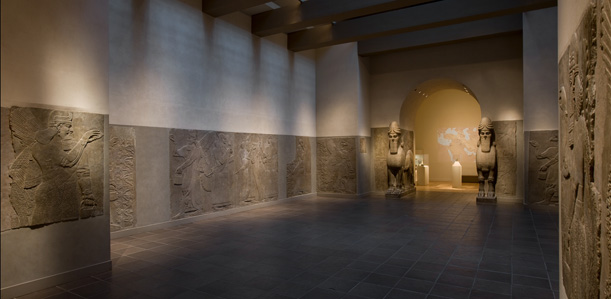While there, we decided to take one docent-led tour, and we all agreed that the art of the Ancient Near East was (a) most unknown to us and (b) most useful for our docent work, so off we went.
We started in front of a map, not nearly as lovely as our mosaic map at the Walters, to discuss the "cradle of civilization." Our guide asked us, "What is civilization?" Answers from the group varied, with the "correct" answer being that a culture needs an economy which is settled enough that people do not have to spend all their time growing and finding their own food. In the Ancient Near East, there was civilization, but still close to agrarian roots, so people were very close to their animals. We examined this lovely object as an example of that point. As we have been taught at the Walters, she did very little in the way of "art history" - I had no idea which culture or what year this object was from until I saw it on the website days later.
We moved on to the system of writing developed in these cultures, and learned that cuneiform was not a language but a system of writing, like our alphabet. At its height it was used to write at least 18 languages. The object on the right, below, was a scribe's dictionary, used to help the scribe translate between the different languages. The object on the left interested me - it was a legal brief, with each party writing their version of events on one side and then submitting it in a stone "envelope" to the judge, who would then decide.
As trade developed so did the need to mark personal property, so we examined a case full of cylinder seals. Each family would have a seal, often combining pictures and words, and would roll it across wet clay or hot wax to show a flat seal.
Up next, a highlight of the tour, an entire room full of reliefs from the palace of Ashurnasirpal. The room was built to the known dimensions of his audience hall, but the reliefs themselves came from various rooms. Everything was designed to show the perfection and strength of the king - nothing out of place, nothing wrong. The king is designated by his headgear, as is the genius (three horns for the deity), and by the rosetta of Ishtar bracelets, showing he had permission to rule. The "unibrow" was the height of fashion. The king's sword has two lions on it - only kings were permitted to hunt lions. What a lot of political spin!
The doors are guarded by human-headed bulls. Doors were considered "very tricky places" and were carefully protected. Each of these animals appears to have five legs, so that if one looks at it from the side, there are four, and from the front, two solid legs.
And of course there is a winged "genius" watering the tree of life. Our genius at the Walters doesn't have his tree anymore.
Here's the head of a ruler, done in a very important technique for casting metal. Note the ears - apparently in the Acadian language the word for "wisdom" sounds the same as the words for "ear" so rulers were shown with prominent ears.
Here's another ruler, who intended this statue as a plea to the gods. Note his cap of lamb's wool, like the one worn by Hamid Karzai today, and his unibrow. This is not intended to be a lifelike statue, but a portrait of strength. It is not large, but because it was believed to be imbued with the spirit of its owner, it could be left behind while he traveled allowing him to be in two places at once. How could you rob a statue of its spirit? By chopping its head off, of course.
There were many large installations and too many objects for me to cover them all. We admired this stag vessel from the Hittites of Biblical fame. Apparently the Hittites glorified the animal world. This vessel is exquisitely carved all around. There is a hole in his mouth for liquid to come out of.
I also loved these golden vessels - they were from Parsis, as in Persian, and the Persians were very mobile people. They carried their wealth around in gold.
When Alexander the Great came to this part of the world, he brought Greek ideas and culture along with him. Here's the head of a Sasanian king, in silver.
That was the end of our Ancient Near East tour but not the end of our day at the Met. We commented on and critiqued our guide's presentation, and wandered off to lunch.
Along the way, we found several objects that recalled to us objects we have studied at the Walters. That was really fascinating.
I am not going to catalogue our visit to the Impressionism exhibit. I loved it, but there has been a lot written about it. I'll try to find a link.












No comments:
Post a Comment